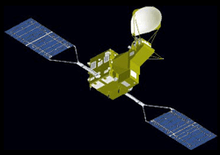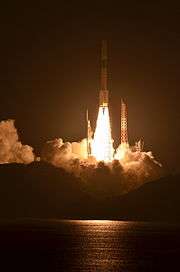Global Change Observation Mission

GCOM (Global Change Observation Mission), is a series of JAXA Earth observation satellites as a successor to the ill-fated ADEOS 2 satellite and to the Aqua Mission. GCOM is, together with the GPM Mission, Japan's contribution to the GEOSS (Global Earth Observation System of Systems).
To increase security and scientific output, JAXA made the decision to split the original ADEOS 2 mission into two models of smaller satellites, GCOM-W for water observation and GCOM-C for climate observation. It is planned to launch three satellites for each mission during the next decade, with each subsequent satellite overlapping to provide continuous coverage.
GCOM-W1

GCOM-W1 (Global Change Observation Mission - Water "SHIZUKU") is the first in the GCOM-W series. Its mission is to observe the water cycle. The satellite carries the AMSR2 (Advanced Microwave Scanning Radiometer 2) instrument, the successor to the AMSR-E carried by Aqua. This microwave radiometer will observe precipitation, water vapor, wind velocity above the ocean, sea water temperature, water levels on land areas, and snow depths. GCOM-W1 was approved in 2006, and development of the satellite started in 2007 with a mission budget of 20 billion Yen (200 Million USD). Mass of the satellite is 1990kg.[1][2]
GCOM-W1 was launched on May 17, 2012 via a H-IIA rocket, and it flies in a sun-synchronous orbit as part of the "A-train" satellite constellation. It successfully began collecting data on July 4, 2012. Its planned lifespan of 5 years means that the satellite is set to operate until 2017, although JAXA hopes that it will last longer.[3]
GCOM-C1
GCOM-C1, the first satellite in the GCOM-C series, will monitor global climate change by observing the surface and atmosphere of Earth over the course of 5 years. Through use of its SGLI (Second generation GLobal Imager) optical instrument, it will collect data related to the carbon cycle and radiation budget, such as measurements of clouds, aerosols, ocean color, vegetation, and snow and ice. From its sun-sychronous orbit, SGLI will collect a complete picture of Earth every 2-3 days with a resolution of 250-1000m, across the UV, visible, and infrared spectrums. Mass of the satellite is 2000kg.[4]
GCOM-C1 has a scheduled launch date of 2016.
References
- ↑ GCOM-W1 at NSSDC
- ↑ GCOM-W at JAXA
- ↑ "SHIZUKU Observation Data Acquired by AMSR2". JAXA. Retrieved 2 July 2014.
- ↑ "JAXA: Global Change Observation Mission - Climate (GCOM-C)". Retrieved 2 July 2014.